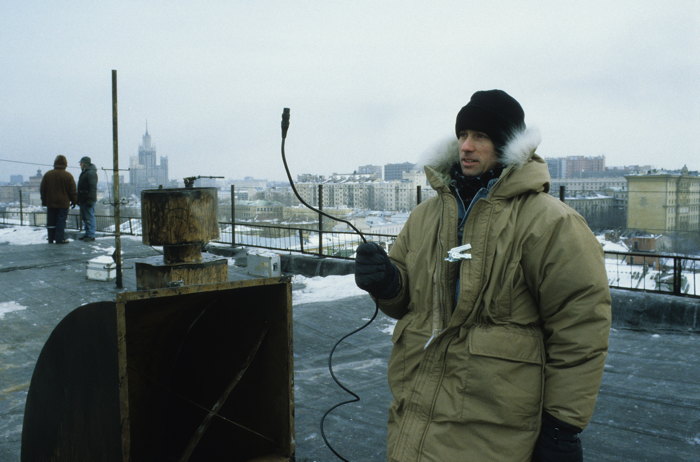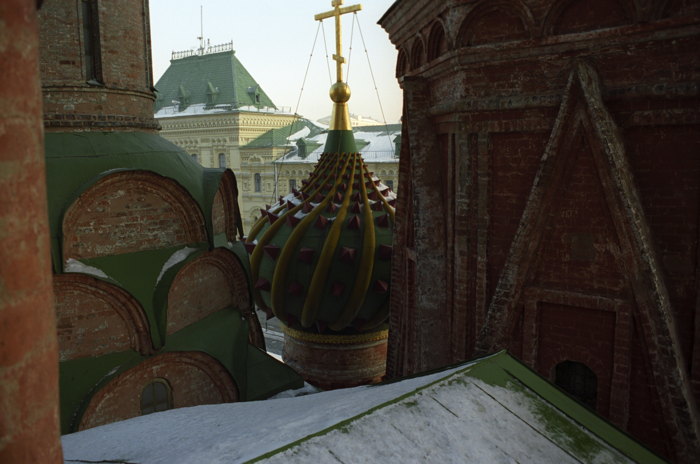Preserved Socialist Leaders Pt. 1: Lenin |
 We went to Moscow twice for The Saint in 1996. First when it was true winter, then again when it thawed. It's about minus twenty in the picture above, and that's the battery cable almost rigid. |
| Some people collect stamps, bottle tops and paper ephemera - I collect Stuffed Socialist Leaders. Not actually for real, of course, like in my front room or anything, that would be just weird. No, if I were going to have any kicking around the house, they'd be in the garage. I'm kidding. I collect them in the same way as I collect Isambard Kingdom Brunel Civil Engineering Projects: By the testament of witness . While we're on the subject of IKB, the brightest highlights - Tamar Bridge, SS Great Britain, the GWR Terminus at Bristol - are, while exciting, do not have the quirky acoustic resonance of his bridge at Maidenhead, of which you will have crossed numerous times if you've been on the Railway to Swindon out of Paddington. A vist by foot is reccomended: It is an eleagant brick arch of super low profile, as IKB was eager to have as little an incline as possible as his railway (broadgauge, of course woop woop) went from London to Swindon. Amazingly, the Maidenhead bridge is still the lowest longest brick arch in the world (citation required). You can walk beneath it, and the most striking feature, aside from the sheer elegance of the arch which seems to leap across the river, are the acoustics. Just stand there and yell, and it warbles back at you in a bizarrely delightful echo that makes that slow stretch of the thames even more lovely. Back to Preserved Socialist Leaders, which we now know that I visit and not hoard greedily in my garage. But unlike stamps and banknotes, stuffed, sorry, preserved Socialist leaders are much more rare, and at the current count there are only three: Lenin in Moscow, Ho Chi Minh in Hanoi, and Mao Tse Tung who is on display in Beijing - and I have yet to see. Unluckily, I missed out on Stalin who was similarly displayed, so to make ammends I have widened the net to include Trotsky, who while not stuffed - at least, not literally, although I think metaphorically there is a sound argument to suggest he was - who is buried in the comppound in which he was murdered, in what was then a little villa outside Mexico City, but is now very much inside Mexico City. Are you ready? Furniture pushed aside? Children safely in bed? Here we go: |
 No, I am not shitting you, I have actually been on the roof of St Basil's in the Red Square. We needed to recce a camera position so climbed the rickety and very rusted ladder to place ourselves on the platform that is used for the military displays. That's Lenin's tomb on the left, nestled up against the Kremlin Wall. |
 Whilst up there I shot half a roll of film. I'm not sure many people have seen the onions at such close quarters. At 11:00 I had two hours to kill before catching the coach to the airport, so elected to go and pay my respects to Vladimir Ilyich Ulyanov Lenin. So I hopped on the Metro, paid my 20p and made the five stop trip to Teatbakhar station, just across the road from the Bolshoi. Red Square is closed between 9:30 and 1:00 every day except Wednesdays to allow visitors to come and pay their respects to the father of Russian Socialism. You approach from the opposite end to St. Basils and are checked by two well turned out guards to make sure you are not carrying a camera, as photographs are strictly prohibited. I saw a couple arguing with a guard whilst waving a bulky Russian SLR, but the guards remained insistent. I wandered into Red Square, following the few people who had decided to make the pilgrimage. They, like me, were more than likely here out of curiosity. The days are long gone when the party faithful and citizens (usually on state organised factory outings) queued up around Red Square to pay their respects. The Mausoleum itself is a squat step pyramid made of black and brown marble, polished highly to a mirror finish and fitted together precisely in massive blocks. I was ushered into the main entrance of the mausoleum, passing below where "Lenin" is spelt out in large bronze letters, and then past two massive bronze doors that run on small wheels resting on steel strips set into the marble flooring. Because the sun was out and the day bright, the dark and cold bowels of the mausoleum rendered me almost blind. I steadied myself, feeling nervously for any steps with an exploratory foot as another honour guard gestured grimly with a finger to his lips. I followed the guard's indication and walked to my left where another guard stood against the wall inside another massive door. I could just about make out the steps in the dim light, and I walked slowly, partly for fear of stumbling, and partly out of respect to the seriousness of the surroundings. There were two flights of steps that must have taken me down about twelve feet below ground level, the interior of the tomb made of the same shiny black marble polished to an impossibly flat finish. Below me was another honour guard. Indeed, there is nowhere you could stand and not be observed by somebody, and they scrutinise you minutely and continuously for any signs of possible transgressions. At the bottom of the short flight I turned left into the main chamber, mounted three steps onto the viewing gallery and there he was. The corpse was reclining on a dias encased in a glass and bronze sarchopagus, as much as I could make out in the darkness of the interior. The bronze sculpture around the base was, I think, of rolled flags or some other patriotic symbol, and the glass enclosing him was so highly polished that it might not have been there at all. His hands were resting on the cloth in front of him, and spotlights illuminated -quite brightly- his hands and face. In direct contradiction to rumour this was no wax copy; this was a real man, a real person. It looks like Lenin too, although the baldness and distinctive moustache and beard lend more to that appearance than anything else. The cadaver has been touched up with powder but it is definitely a corpse; the nails were brown and ridged, the face slightly sunken, old and dry with discolourations about the cheeks and forehead. The skin appears dry but still looks supple; the ears have suffered and deteriorated badly, the lobe and main body of the ear almost rotted completely away. If this had been a wax effigy, then the authorities would have made it look a lot better than this; the minutiae of detail that would be required to make up a model to this degree of accuracy would be quite beyond even the most skilled of film sculptors who excel in grisly props. As my eyes became accustomed to the dark I could see the honour guard at the dias starting to move people on whom he judged had spent too long in the presence of the master. I could see my time was near so I moved on a few feet, and looked around at the chamber itself. The black marble was inset with a zigzag of red, almost crimson, marble that ran around the room; the ceiling above me stepped like the roof of the mausoleum itself, and at the very summit of the room there was a dim indirect light source. There were a couple of red spotlights illuminating the sarcophagus, but their effect was hard to see. Even as I took in all these strange surroundings my time was up. A guard jabbed a finger in my direction and I left obediently, taking the steps up the other side of the building and back blinking into the bright daylight. My meeting with Lenin had taken all of six minutes. I returned to the hotel deep in thought. There are some aspects of the Soviet way that are very noble, and I can understand how -despite all his faults and hypocrisy- Lenin can still be so revered. To many people it was and still is a good idea, a benevolent state at one with its people, where all is provided, and nobody goes hungry. Unfortunately, like so many good ideas, the cause becomes clouded in the practicalities, and Stalin quickly lost the grasp of the concept as he forced the Lenin/Marx plan onto a people who had only just managed to throw off the Czar. When Churchill met Stalin in August 1942, Stalin told Churchill -after the booze had flowed somewhat- how the exigency of power required the actions that he took, particularly in exterminating the Kulaks to force the collective farm policy. Churchill recorded in his diary Burke's dictum: "If I cannot have reform without justice, I will not have reform", but diplomatically did not voice the opinion. Contemporaneous report, much shortened, Wednesday 17th April 1996. |